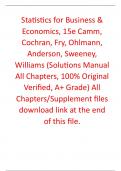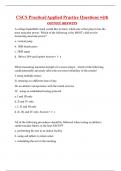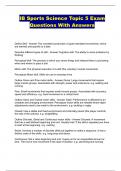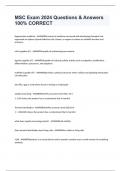Sta�s�cs for Business & Economics, 15e Camm, Cochran, Fry, Ohlmann, Anderson, Sweeney, Williams (Solu�ons Manual All Chapters, 100% Original Verified, A+ Grade) All Chapters/Supplement files download link at the end of this file. Solution and Answer Guide : Camm/Cochran/Fry/Ohlmann/Anderson/Sweeney/Williams, Statistics for Business and Economics, 9780357715857; Chapter 1: Data and Statistics 1 © 202 4 Cengage. All Rights Reserved. May not be scanned, copied or duplicated, or posted to a publicly accessible website, in whole or in part. Solution and Answer Guide Camm/Cochran/Fry/Ohlmann/Anderson/Sweeney/Williams , Statistics for Business and Economics , 9780357715857 ; Chapter 1: Data and Statistics Table of Contents Supplementary Exercises ................................ ................................ ................................ .............. 1 Supplementary Exercises 1. Wall Street Journal Subscriber Characteristics. A Wall Street Journal (WSJ) subscriber survey asked 46 questions about subscriber characteristics and interests. State whether each of the following questions provides categorical or quantitative data. LO 2 a. What is your age? b. Are you married? c. When did you first start reading the WSJ? High school, college, early career, midcareer, late career, or retirement? d. How long have you been in your present job or position? e. What type of vehicle are you considering for your next purchase? Nine response categories include sedan, sports car, SUV, minivan, and so on. Solutions: a. Quantitative b. Categorical c. Categorical d. Quantitative e. Categorical 2. Comparing Tablet Computers. Tablet PC Comparison provides a wide variety of information about tablet computers. The company’s website enables consumers to easily compare different tablets using factors such as cost, type of operating system, display size, battery life, and CPU manufacturer. A sample of 10 tablet computers is shown in Table 1.6 (Tablet PC Comparison website). LO 1, 2 a. How many elements are in this data set? b. How many variables are in this data set? c. Which variables are categorical and which variables are quantitative? d. What type of measurement scale is used for each of the variables? Solution and Answer Guide : Camm/Cochran/Fry/Ohlmann/Anderson/Sweeney/Williams, Statistics for Business and Economics, 9780357715857; Chapter 1: Data and Statistics 2 © 202 4 Cengage. All Rights Reserved. May not be scanned, copied or duplicated, or posted to a publicly accessible website, in whole or in part. Solutions: a. The 10 elements are the 10 tablet computers. b. Five variables: Cost ($), Operating System, Display Size (inches), Battery Life (hours), and CPU Manufacturer c. Categorical variables: Operating System and CPU Manufacturer Quantitative variables: Cost ($), Display Size (inches), and Battery Life (hours) d. Variable Measurement Scale Cost ($) Ratio Operating system Nominal Display size (inches) Ratio Battery life (hours) Ratio CPU manufacturer Nominal 3. Tablet PCs: Cost, CPU, and Operating System. Refer to Table 1.6. LO 3 a. What is the average cost for the tablets? b. Compare the average cost of tablets with a Windows operating system to the average cost of tablets with an Android operating system. c. What percentage of tablets use a CPU manufactured by TI OMAP? d. What percentage of tablets use an Android operating system? Solutions: a. Average cost = 5829/10 = $582.90 b. Average cost with a Windows operating system = 3616/5 = $723.20 Average cost with an Android operating system = 1714/4 = $428.5 The average cost with a Windows operating system is much higher. Solution and Answer Guide : Camm/Cochran/Fry/Ohlmann/Anderson/Sweeney/Williams, Statistics for Business and Economics, 9780357715857; Chapter 1: Data and Statistics 3 © 202 4 Cengage. All Rights Reserved. May not be scanned, copied or duplicated, or posted to a publicly accessible website, in whole or in part. c. Ten of 10 or 20% use a CPU manufactured by TI OMAP d. Four of 10 or 40% use an Android operating system 4. Comparing Phones. Table 1.7 shows data for eight phones ( Consumer Reports ). The Overall Score, a measure of the overall quality for the phone, ranges from 0 to 100. Voice Quality has possible ratings of poor, fair, good, very good, and excellent. Talk Time is the manufacturer’s claim of how long the phone can be used when it is fully charged. LO 1, 2 a. How many elements are in this data set? b. For the variables Price, Overall Score, Voice Quality, and Talk Time, which variables are categorical and which variables are quantitative? c. What scale of measurement is used for each variable? Solutions: a. There are eight elements in this data set; each element corresponds to one of the eight models of cordless telephones. b. Categorical variables: Voice Quality and Handset on Base Quantitative variables: Price, Overall Score, and Talk Time c. Price: ratio measurement Overall score: interval measurement Voice quality: ordinal measurement Handset on base: nominal measurement Talk time: ratio measurement 5. Summarizing Phone Data. Refer to the data set in Table 1.7. LO 3 a. What is the average price for the phones? b. What is the average talk time for the phones? c. What percentage of the phones have a voice quality of excellent? Solutions: a. Average price = 545/8 = $68.13









